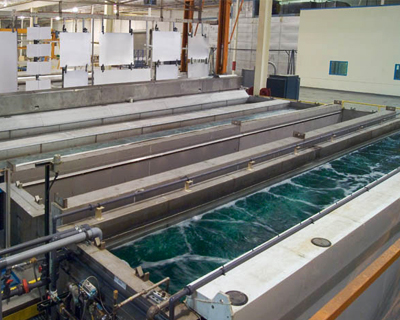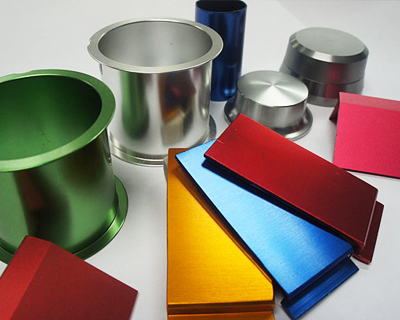Aluminum Anodizing
AKA Anodize, Anodizing, Anodic Coating or Aluminum Oxide
About Aluminum Anodizing
Aluminum Anodizing is an electrolytic passivation process used to increase the thickness of the natural oxide layer on the surface of metal parts. Anodizing increases corrosion resistance and wear resistance, and provides better adhesion for paint primers and glues than bare metal. Anodic films can also be used for a number of cosmetic effects, either with thick porous coatings that can absorb dyes or with thin transparent coatings that add interference effects to reflected light. Anodizing is also used to prevent galling of threaded components and to make dielectric films for electrolytic capacitors.
This simple infographic shows how the anodizing process works. As you can see, the coating equally penetrates as well as builds up onto the surface of the aluminum material. Dye can be added for color, but not necessary for successful coating.
The Process
The anodized aluminum layer is grown by passing a direct current through an electrolytic solution, with the aluminum object serving as the anode (the positive electrode). The current releases hydrogen at the cathode (the negative electrode) and oxygen at the surface of the aluminum anode, creating a build-up of aluminum oxide. Alternating current and pulsed current is also possible but rarely used. The voltage required by various solutions may range from 1 to 300 V DC, although most fall in the range of 15 to 21 V. Higher voltages are typically required for thicker coatings formed in sulfuric and organic acid. The anodizing current varies with the area of aluminum being anodized, and typically ranges from 0.3 to 3 amperes of current per square decimeter (20 to 200 mA/in²).
Sulfuric Acid Anodizing
Sulfuric acid is the most widely used solution to produce anodized coating. Coatings of moderate thickness 1.8 m to 25 m (0.00007″ to 0.001″) are known as Type II, as named by Mil-PRF-8625, while coatings thicker than 25 m (0.001″) are known as Type III, hardcoat, or engineered anodizing. Very thin coatings similar to those produced by chromic anodizing are known as Type IIB. Thick coatings require more process control, and are produced in a refrigerated tank near the freezing point of water with higher voltages than the thinner coatings. Hard anodizing can be made between 25 and 150 ?m (0.001″ to 0.006″) thick. Anodizing thickness increases wear resistance, corrosion resistance, ability to retain lubricants, and electrical and thermal insulation. Standards for thin sulfuric anodizing are given by Mil-PRF-8625 Types II and IIB, AMS 2471 (undyed), and AMS 2472 (dyed). Standards for thick sulfuric anodizing are given by Mil-PRF-8625 Type III, AMS 2469, BS 5599, BS EN 2536 and the obsolete AMS 2468 and DEF STAN 03-26/1.
What you can do
Fingerprints, moisture and other things to avoid
- Wear Gloves. We use nitrile gloves at all times when handling aluminum. This is for two reasons. One, aluminum dust can be harmful to your health with extensive exposure. Two, cosmetically, oils from your fingers on uncoated aluminum can leave finger print marks and even corrode the aluminum.
- Keep parts covered or contained. Raw aluminum exposed to water or even air can oxidize. This can prove challenging to create a consistent, cosmetic finish.
- If you clean your parts, use dish soap or alcohol. Acidic or alkaline cleaners can corrode aluminum.
- If your parts have been polished, the buffing/polishing compound should be cleaned prior to arriving to us as it may not clean off during our preclean and etch procedure. A lot of people are told by the polisher that it will come off during the anodize process; this is a misconception.
Our preclean process does account for, and take care of most of these issues, but it isn’t a guaranteed fail-safe.
Packaging
- Please be sure to package parts so they cannot be damaged on their way to us. Roads are rough, and parts can bounce, bang and rub against each other. While we do not act as our customer’s quality control, we DO inspect parts upon arrival. If we notice significant damage when they arrive, we will be sure to contact you.
- Our general practice is to return parts in the same manner/packaging or better than how they arrived. We are not a packaging company though, so we only have cardboard and brown paper in stock to use in addition to whatever materials accompanied parts.
Let us know
- We are extremely customer service oriented. Just let us know any concerns or issues you may have prior to sending in your order. From turn-around times to special handling and packaging, we’ll be happy to work with you to accommodate whatever requirements you have.
For your information
We do not “etch to a finish”
- Whatever “imperfections” will likely remain after anodize finish. Scratches, machine marks, extrusion lines, etc will not be hidden by the anodize process. They may even become more obvious. Our preclean and etch process does help remove minor/fine scratches, but it should not be relied upon as a solution.
Welds may have discoloring
- Depending on what was used for welding, the anodize finish may vary in appearance on or around the welds.
Color matching
- The anodizing industry has a LOT of color dye possibilities, but they do not necessarily match up with say, a powder coat or wet paint color wheel. So it is hard to match anodizing to a different type of finish. Even the same color dye can look different on different aluminum alloys. For this reason, when requiring consistency, it is important to use all the same material when fabricating parts. It is also very helpful to provide or create a sample part as a color match reference.
Alloys
- Not all alloys are created equal when it comes to anodizing them. 6000 & 5000 are best, while 2000 series can be difficult to achieve consistency.
- Please note that due to the inconsistent properties of the Mic-6 material, we will be unable to guarantee a consistent cosmetic coating on all Mic-6 machined parts. Please feel free to contact us for alternative material solutions to ensure our services meet your expectations.
Got A Job For Us?
Solid, long-term customer relationships are the backbone of our company.
From the moment you contact us to delivery of your finished piece, our focus is on excellent results and diligent customer service.






